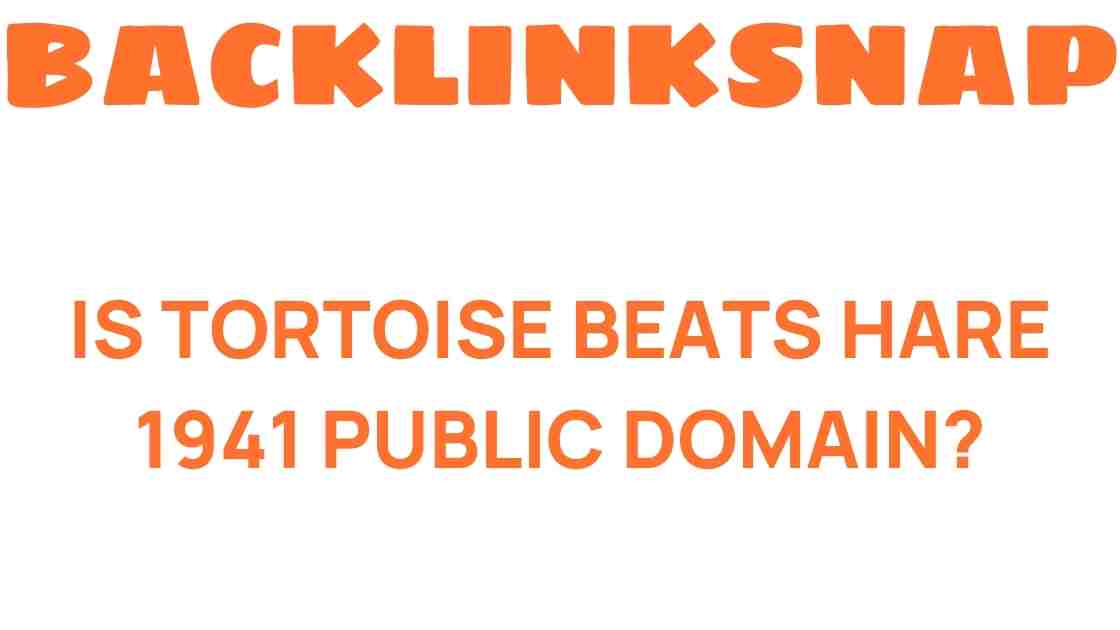Is Tortoise Beats Hare 1941 Public Domain? Unraveling the Mystery
The classic animated short film Tortoise Beats Hare, released in 1941 by Warner Bros., is a staple in the realm of animation history. Its timeless story, which draws from Aesop’s famous fable of the same name, features the slow but steady tortoise triumphing over the overconfident hare. But as we delve into the nuances of copyright law and the public domain status of this beloved film, the question arises: is Tortoise Beats Hare indeed in the public domain? Let’s unravel this mystery, exploring its copyright status, the implications for creative works, and the broader landscape of classic films.
Understanding Copyright Law
To grasp the public domain status of Tortoise Beats Hare, it’s essential to have a fundamental understanding of copyright law. Copyright is a form of intellectual property protection that grants the creator exclusive rights to use, distribute, and reproduce their work for a certain period. This protection is designed to encourage creativity by allowing creators to profit from their works.
Under U.S. copyright law, works published before 1978 were initially granted a copyright term of 28 years, which could be renewed for an additional 67 years, totaling 95 years. Therefore, any work published in 1941, like Tortoise Beats Hare, would need to have its copyright renewed to remain protected beyond its initial term.
The Public Domain Status of Tortoise Beats Hare
As of now, Tortoise Beats Hare is indeed in the public domain. This status results from a combination of factors:
- Copyright Renewal: Warner Bros. did not renew the copyright for this short film after its initial term expired, resulting in it entering the public domain.
- Expiration of Copyright: Given the film’s release date of 1941, it has surpassed the 95-year copyright period, making it available for public use.
This public domain status opens the door for various uses, from educational purposes to creative adaptations, without the risk of infringing on copyright laws. Artists, filmmakers, and educators can freely utilize Tortoise Beats Hare in their projects, contributing to its legacy in animation history.
The Significance of Public Domain Works
Public domain works like Tortoise Beats Hare play a crucial role in the cultural landscape. They serve as a foundation for new creative endeavors, enabling artists to build upon the past. Public domain status can lead to:
- Adaptations: Filmmakers and animators can reinterpret the story, bringing fresh perspectives while honoring the original.
- Educational Resources: Teachers can incorporate the film into lessons about storytelling, animation techniques, and moral lessons, enriching students’ learning experiences.
- Creative Remixes: Musicians and content creators can sample or remix the film, creating new works that resonate with contemporary audiences.
The Legacy of Tortoise Beats Hare
Tortoise Beats Hare is more than just a film; it represents a significant moment in animation history. Directed by Chuck Jones, the short film showcases the early animation techniques that would later define Warner Bros.’ output. The characters, particularly the tortoise and the hare, have become iconic figures in popular culture.
Moreover, the film’s central message—the value of perseverance over arrogance—continues to resonate with audiences today. This enduring appeal is a testament to the skill with which the story was crafted and its relevance across generations.
Exploring Other Classic Films in the Public Domain
Aside from Tortoise Beats Hare, numerous classic films have entered the public domain, allowing for widespread access and creative reinterpretation. Some notable examples include:
- It’s a Wonderful Life (1946)
- The Great Train Robbery (1903)
- Night of the Living Dead (1968)
- Charley Chase Comedies (various shorts)
These films have inspired countless remakes, adaptations, and studies, showcasing the endless possibilities that arise when creative works enter the public domain.
How to Use Tortoise Beats Hare in Your Projects
If you’re interested in incorporating Tortoise Beats Hare into your own work, here are a few ideas:
- Film Studies: Analyze its animation techniques and narrative structure in a classroom setting.
- Creative Projects: Use the characters in a new animated short or a digital art project, exploring modern themes.
- Public Screenings: Organize community events to showcase classic animations, fostering appreciation for the art form.
Frequently Asked Questions
1. What does it mean for a film to be in the public domain?
A film in the public domain is no longer protected by copyright, allowing anyone to use, share, or adapt it without permission or payment.
2. How can I find out if a film is in the public domain?
You can check the copyright status through resources like the U.S. Copyright Office or databases dedicated to public domain works.
3. Can I make money off a public domain film?
Yes, you can use public domain films for commercial purposes, such as creating new adaptations or incorporating them into your projects.
4. Are there any restrictions when using public domain works?
While public domain works can be freely used, be cautious about using trademarks or elements that may still be protected under different laws.
5. What should I consider when adapting a public domain work?
Consider the original message, cultural context, and audience when creating adaptations to ensure respect for the source material.
6. What other Warner Bros. cartoons are in the public domain?
Several early Warner Bros. cartoons, including some of the Looney Tunes series, have entered the public domain, offering numerous opportunities for creative use.
Conclusion
In conclusion, Tortoise Beats Hare is not just a charming animated short from 1941; it is a significant piece of our cultural heritage now residing in the public domain. This status empowers a new generation of creators to engage with classic works, fostering innovation and preserving the legacy of animation history. As we celebrate the enduring themes of perseverance and humility found in this story, we also recognize the importance of public domain works in promoting creativity and cultural exchange.
This article is in the category Digital Marketing and created by BacklinkSnap Team




